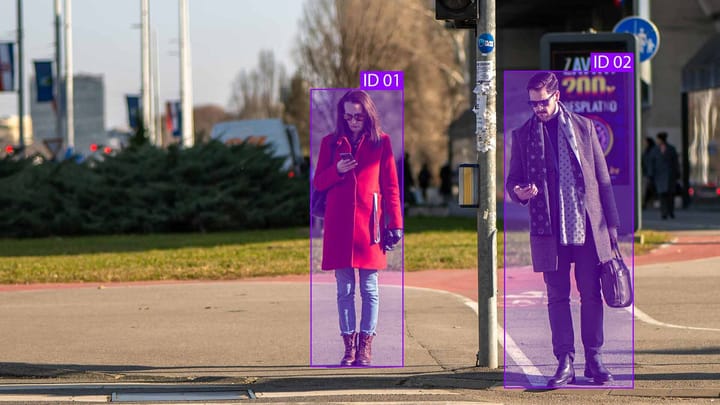Data Annotation's Role in Machine Learning: An Overview

Data annotation is a fundamental component of machine learning, playing a vital role in training models and enabling them to understand and interpret data accurately. By providing labeled data, annotations serve as the ground truth that guides machine learning algorithms in learning patterns and making accurate predictions. Various types of data annotation, including image annotation, text annotation, video annotation, and audio annotation, are utilized across different domains to enhance the performance and reliability of machine learning models.
To facilitate the annotation process, there are data labeling services and data annotation tools available, offering efficient solutions for accurately labeling and categorizing data. These services and tools streamline the annotation workflow, ensuring the quality and accuracy of annotations, and ultimately improving the performance of machine learning models.
Key Takeaways:
- Data annotation is crucial in machine learning for training models and making accurate predictions.
- Image annotation, text annotation, video annotation, and audio annotation are different types of data annotation techniques.
- Data labeling services and annotation tools exist to facilitate the annotation process.
- The quality and accuracy of annotations directly impact the performance and reliability of machine learning models.
- Data annotation is essential for various applications, including object recognition, sentiment analysis, and speech recognition.
What is Annotation in Machine Learning?
Annotation in machine learning refers to the process of labeling data to provide meaningful information to algorithms. It involves adding annotations or tags to data points to convey valuable information to algorithms more easily. Annotations can take different forms depending on the type of data being annotated, such as image annotation, text annotation, video annotation, and audio annotation. The effectiveness of annotations lies in their ability to provide context and structure to the data, enabling the algorithms to extract meaningful knowledge from the labeled examples.
Annotations play a crucial role in training machine learning models by providing a reference or ground truth that algorithms can learn from. By labeling data accurately, annotations aid in teaching models to recognize patterns, classify information, or perform specific tasks.
For example, in image annotation, objects, regions, or specific features within an image are labeled to train computer vision models. Text annotation involves labeling and categorizing textual data, contributing to natural language processing tasks like named entity recognition and sentiment analysis. In video annotation, objects or actions within video sequences are labeled, facilitating video analysis in applications such as surveillance and autonomous technology. Audio annotation encompasses labeling and transcribing audio data to enhance speaker identification, speech emotion recognition, and audio transcription tasks.
Each type of annotation technique contributes to the development and improvement of machine learning models in their respective domains. The labeled data creates a foundation that enables the models to interpret and understand the input they receive, resulting in more accurate and reliable predictions or outputs.
By leveraging the power of annotation in machine learning, organizations can unlock the potential of their data and build advanced models that can automate processes, make informed decisions, and drive innovation across various industries.
Benefits of Annotation in Machine Learning
Annotations provide context and structure to the data, enabling algorithms to extract meaningful knowledge from labeled examples.
Annotated data serves as the ground truth for training machine learning models, facilitating pattern recognition and accurate predictions.
By leveraging annotations, organizations can build advanced models that automate processes and make informed decisions.
Annotation enhances the accuracy and reliability of machine learning models in various domains, from computer vision to natural language processing.
Types of Data Annotation: Image Annotation
Image annotation is a critical technique for training computer vision models to accurately recognize and classify objects within images. By labeling objects, regions, or specific features, image annotation provides valuable information to algorithms, enabling them to understand the presence and identity of objects. This enhances the accuracy and performance of computer vision algorithms, particularly for applications such as object recognition and image classification.
Several image annotation techniques are employed to annotate images effectively:
- Bounding boxes: This technique involves drawing rectangular boxes around objects or regions of interest within an image, clearly indicating their boundaries.
- Polygons: In polygon annotation, the contours of objects are outlined using a series of connected vertices, allowing for more precise labeling.
- Key points: Key point annotation involves marking specific points of interest, such as the corners of objects or the joints of a skeleton, to denote significant features for recognition.
- Semantic segmentation: This technique assigns semantic labels to pixels or regions within an image, enabling algorithms to differentiate objects and understand their boundaries.
Image annotation techniques, such as bounding boxes and semantic segmentation, play a crucial role in object recognition and image classification, enabling machines to accurately identify and classify objects within images.
| Technique | Description |
|---|---|
| Bounding boxes | Rectangular boxes outlining objects or regions of interest within an image |
| Polygons | Contours of objects outlined using a series of connected vertices |
| Key points | Specific points of interest marked within an image |
| Semantic segmentation | Semantic labels assigned to pixels or regions within an image |
Types of Data Annotation: Text Annotation
Text annotation is a crucial process in machine learning, involving the labeling and categorizing of textual data, such as documents, articles, or sentences. It plays a significant role in natural language processing tasks, enabling machines to understand and interpret the text accurately.
One of the primary applications of text annotation is named entity recognition, which involves identifying and classifying named entities within the text, such as people, organizations, locations, and dates. Sentiment analysis is another important task in which text annotation is utilized. It involves determining the sentiment or emotion expressed in the text, enabling sentiment classification for various purposes, such as customer feedback analysis or social media monitoring.
Part-of-speech tagging is yet another essential task enabled by text annotation. It involves assigning grammatical information, such as noun, verb, adjective, or adverb, to each word in the text. This provides valuable context and structure to the language, enabling machines to analyze and process the text effectively.
"Text annotation techniques provide valuable context and meaning to words within the text, enabling machines to understand and interpret the text accurately."
Text annotation plays a crucial role in various applications, including information extraction, text categorization, and question answering. By labeling and categorizing textual data, machine learning models can extract relevant information, classify texts into different categories, and provide accurate answers to user queries.
Overall, text annotation empowers machines to make sense of textual data, enabling them to perform a wide range of natural language processing tasks effectively. It enhances the understanding and interpretation of textual information, contributing to the development of advanced machine learning models in various domains.
Example of Text Annotation Workflow
Understanding the process of text annotation can provide further insights into its significance and impact. Here's an example of a typical text annotation workflow:
- Annotators receive a set of documents or sentences to be annotated.
- They read and analyze the text, identifying relevant entities, sentiments, and parts of speech.
- Using annotation tools, annotators label and categorize the identified entities, sentiments, and parts of speech.
- The annotated data is then used to train machine learning models, allowing them to learn patterns and make accurate predictions in various natural language processing tasks.
Through this workflow, text annotation facilitates the development of robust and reliable machine learning models that can effectively process and analyze textual data.

Types of Data Annotation: Video Annotation
Video annotation plays a critical role in enabling computer vision models to analyze and understand video content. This process involves labeling objects or actions within video sequences, allowing machines to track objects, classify actions, and identify specific time intervals or events. Video annotation techniques such as object tracking, action recognition, and temporal annotation enhance the capabilities of computer vision algorithms, facilitating applications such as surveillance, autonomous technology, and activity recognition.
Object tracking is a video annotation technique that focuses on following and tracing specific objects or targets throughout a video. By tracking objects, computer vision models can understand the movement and behavior of those objects within the video, improving object recognition and scene understanding.
Action recognition is another video annotation technique that involves labeling and categorizing different actions or activities performed within a video. This annotation enables machines to recognize and distinguish various actions, empowering applications like human activity analysis, sports video analysis, and video surveillance.
Temporal annotation is the process of marking specific time intervals or events within a video. It helps in identifying crucial moments or incidents that are significant for video analysis. Temporal annotation plays a vital role in applications like event detection, video summarization, and video search, enabling machines to pinpoint and extract relevant information.
Example: Video Annotation for Autonomous Driving
An illustrative example of video annotation is its application in autonomous driving. By annotating objects, actions, and temporal information within video footage, computer vision models can identify other vehicles, pedestrians, traffic signs, and road markings. This annotated data serves as a training ground truth for autonomous vehicles to make informed decisions and navigate safely on the roads. The accuracy and reliability of video annotation heavily influence the performance and safety of autonomous driving systems.
| Video Annotation Technique | Description |
|---|---|
| Object Tracking | Tracks and follows objects or targets throughout the video |
| Action Recognition | Labels and categorizes different actions or activities performed within the video |
| Temporal Annotation | Marks specific time intervals or events within the video |
Types of Data Annotation: Audio Annotation
Audio annotation plays a crucial role in machine learning by labeling and transcribing audio data, enabling the extraction of valuable insights and patterns. This type of annotation is widely used in tasks such as speaker identification, speech emotion recognition, and audio transcription. Through various techniques like phonetic annotation, speaker diarization, and event labeling, audio annotation enhances the performance and accuracy of machine learning models in applications related to audio data.
Speaker Identification
Speaker identification is a key task in audio annotation, where machine learning models are trained to recognize and distinguish different speakers in audio recordings. By labeling the speakers and their corresponding segments in the data, models can accurately identify and differentiate speakers, enabling applications such as voice biometrics and speaker recognition systems.
Speech Emotion Recognition
Speech emotion recognition involves annotating audio data to identify and categorize the emotions expressed in spoken language. By labeling emotions such as happiness, sadness, anger, or surprise, machine learning models can accurately classify and interpret the emotional states of speakers. This enables applications in sentiment analysis, voice-based virtual assistants, and emotional speech recognition.
Transcription
Transcription involves the process of converting audio data into written text. Through audio annotation techniques like phonetic annotation and automatic speech recognition, machine learning models can transcribe spoken language accurately. Transcription is essential in various domains, including media and entertainment, customer support, and accessibility for the hearing impaired.
Audio annotation is a powerful tool for unlocking insights and understanding in audio data. By providing labeled information through techniques such as speaker identification, speech emotion recognition, and transcription, machine learning models can effectively analyze and interpret audio, creating valuable applications and solutions across industries.
Techniques of Audio Annotation
| Technique | Description |
|---|---|
| Phonetic Annotation | Annotating phonetic details and transcription of speech sounds. |
| Speaker Diarization | Distinguishing and labeling different speakers within audio recordings. |
| Event Labeling | Annotating specific events or occurrences in audio data. |
Why Does Annotation in Machine Learning Matter?
Annotation plays a crucial role in machine learning as it provides labeled data that serves as the ground truth for training models. Without accurate and properly annotated data, machine learning algorithms would struggle to learn patterns and make meaningful predictions.
Annotation enables models to make informed decisions and predictions based on their training, even when faced with previously unseen data.
The quality and accuracy of annotations directly impact the performance and reliability of machine learning models, making annotation an essential component of the machine learning pipeline.
| Importance of Annotation in Machine Learning | Role of Annotation in Machine Learning |
|---|---|
| Provides labeled data for training models | Enables models to make informed predictions |
| Aids in learning patterns and making meaningful predictions | Improves the performance and reliability of models |
| Ensures accuracy and validity of machine learning models | Enhances decision-making in the face of unseen data |
Key Challenges of Data Annotation in Machine Learning
Data annotation in machine learning presents several challenges that need to be addressed for successful implementation. These challenges include:
- Annotation Quality: High-quality annotations are crucial for training accurate and reliable machine learning models. Ensuring consistent, accurate, and detailed annotations that capture relevant information is essential for achieving optimal results.
- Scalability: The exponential growth of data poses a significant challenge in managing and annotating large volumes of data efficiently. Scaling annotation processes to handle increasingly large datasets while maintaining quality and accuracy is critical.
- Subjectivity: Data annotation can involve subjective judgments, such as determining the boundaries of objects or identifying sentiment. Managing subjectivity requires clear guidelines and continuous communication among annotators to maintain consistency and minimize bias.
- Consistency: Achieving consistent annotations across different annotators is crucial to ensure reliable training data. Consistency ensures that models can generalize effectively and make accurate predictions on unseen data.
- Privacy and Security: Data annotation often involves sensitive information, such as personally identifiable information (PII). Ensuring the privacy and security of annotated data by implementing robust data protection measures is essential to maintain trust and compliance.
Addressing these challenges is vital for obtaining high-quality annotated datasets that enable the development of accurate and reliable machine learning models.
"High-quality annotations are crucial for providing reliable training data for machine learning models."
Use Cases of Data Annotation in Machine Learning
Data annotation is a critical component in machine learning with various applications across different domains. Let's explore some common use cases where data annotation plays a vital role:
Medical Imaging
In the field of medical imaging, data annotation is crucial for accurate disease diagnosis and treatment planning. Annotated medical images assist healthcare professionals in identifying and analyzing abnormalities, enabling timely and effective interventions.
Autonomous Vehicles
Data annotation is essential for training autonomous vehicles to understand and interact with their environment. Annotated data helps in object recognition, allowing autonomous vehicles to accurately identify pedestrians, traffic signs, and other vehicles. It also contributes to road scene understanding, enabling autonomous vehicles to navigate safely and make informed decisions on the road.
Ecommerce
Ecommerce platforms heavily rely on data annotation to enhance user experience and drive sales. Annotated product images and descriptions are used for recommendation systems, providing personalized product suggestions to customers based on their preferences and purchase history.
Sentiment Analysis
Sentiment analysis, which involves determining the sentiment or opinion expressed in customer reviews or social media posts, benefits greatly from data annotation. Annotated customer reviews serve as training data for sentiment classification models, enabling businesses to extract valuable insights and make data-driven decisions to improve their products and services.
Virtual Assistants
Data annotation is instrumental in training virtual assistants to accurately interpret and respond to user commands. Annotated voice recordings are used for speech recognition and natural language understanding, enabling virtual assistants to understand user queries and provide relevant and context-aware responses.
These are just a few examples of how data annotation is applied in machine learning to improve the performance and reliability of models across various domains. The precise and accurate labeling provided by data annotation enables machines to learn and make more informed decisions, ultimately enhancing the overall user experience and driving innovation.

Human vs. Machine in Data Annotation
When it comes to data annotation, there is an ongoing debate about the roles of humans and machines. Both have their advantages and limitations, and finding the right balance is crucial for accurate and meaningful annotations.
Machine automation in data annotation has the potential to streamline the process by leveraging algorithms to label data automatically. This approach is efficient, fast, and scalable, allowing large volumes of data to be annotated quickly.
However, human expertise in data annotation cannot be replaced. Human annotators bring a level of understanding, intuition, and domain-specific knowledge that machines currently lack. They are able to interpret complex contexts, understand nuances, and make subjective decisions that machines find challenging.
Human annotators play a vital role in creating ground truth datasets, ensuring the accuracy and quality of annotations. Their involvement improves the performance and reliability of machine learning models trained on annotated data. With their expertise, human annotators can provide valuable insights, identify edge cases, and handle ambiguous situations that machines struggle with.
"Human annotators bring a deeper understanding of intent, context, and domain-specific knowledge to the annotation process."
Additionally, human involvement can help address biases and inconsistencies in data annotation. By carefully selecting and training human annotators, organizations can ensure a high level of accuracy and reliability in annotations.
Although machine automation offers advantages in terms of speed and scalability, it is essential to strike a balance between human expertise and machine automation in data annotation. By combining the strengths of humans and machines, organizations can maximize the efficiency, accuracy, and effectiveness of the annotation process.
The Benefits of Human Expertise in Annotation
Human expertise in data annotation brings several key benefits:
- Deep understanding of intent and context: Human annotators can interpret complex data, understand subtle nuances, and accurately label data based on the intended meaning.
- Domain-specific knowledge: Human annotators bring domain-specific knowledge and subject matter expertise, enabling them to make informed decisions and handle industry-specific annotation tasks.
- Handling ambiguity and edge cases: Human annotators excel at handling ambiguous situations and edge cases that can arise in data annotation. They can make judgment calls and provide valuable insights.
- Quality control and feedback loop: Human annotators can actively participate in the quality control process by reviewing and providing feedback on automated annotations. This iterative feedback loop helps improve the accuracy and reliability of the annotation process over time.
The Role of Machine Automation in Annotation
Machine automation in data annotation offers several advantages:
- Efficiency and scalability: Machines can annotate large volumes of data quickly and efficiently, enabling organizations to process and label massive datasets with ease.
- Consistency: Machines can provide consistent annotations, reducing human error and ensuring uniformity in labeling.
- Speed: Automated annotation tools can expedite the annotation process, enabling organizations to save time and resources.
- Cost-effectiveness: Machine automation can reduce the cost of annotation by minimizing the need for extensive human labor.
However, it is important to note that machine automation has limitations, particularly in cases that require subjective analysis, contextual understanding, or handling complex semantics. In such cases, human expertise remains crucial.
Incorporating Human and Machine Collaboration
To achieve the best results, organizations should aim for a collaborative approach that leverages the strengths of both humans and machines. This can include:
- Using human annotators to curate high-quality annotated datasets that serve as the ground truth for model training.
- Employing automated tools and algorithms to assist human annotators in the annotation process, speeding up certain tasks and enhancing efficiency.
- Implementing a feedback loop between human annotators and automated systems to continuously improve and refine annotations.
- Regularly reviewing and auditing the annotations to maintain quality and consistency.
By combining the power of human expertise with machine automation, organizations can achieve accurate, reliable, and scalable data annotation, ultimately enhancing the performance and reliability of machine learning models.
| Human Annotation | Machine Automation |
|---|---|
| Deep understanding of intent and context | Efficiency and scalability |
| Domain-specific knowledge | Consistency |
| Handling ambiguity and edge cases | Speed |
| Quality control and feedback loop | Cost-effectiveness |
Conclusion
Data annotation plays a pivotal role in machine learning, enabling models to learn from labeled examples and make accurate predictions. The importance of annotation in machine learning cannot be overstated, as it provides the necessary ground truth data for training models. Different annotation techniques, such as image annotation, text annotation, video annotation, and audio annotation, are used to train machine learning models in various domains.
The challenges associated with data annotation, including annotation quality, scalability, subjectivity, consistency, and privacy and security, must be addressed to ensure the success of data annotation projects. High-quality annotations are crucial for generating reliable training data and improving the performance and reliability of machine learning models.
By leveraging both human expertise and machine automation, organizations can generate high-quality labeled datasets and develop accurate and reliable machine learning models. Human annotators provide domain-specific knowledge and expertise, ensuring the accuracy and meaning of annotations. At the same time, machine automation can help streamline the annotation process and improve scalability.
As the field of machine learning continues to advance, the importance of data annotation will only grow. The quality and accuracy of annotations directly impact the performance and reliability of machine learning models, making annotation an essential component of the machine learning pipeline.
Whether it's image annotation for object recognition, text annotation for sentiment analysis, video annotation for action recognition, or audio annotation for speaker identification, data annotation plays a crucial role in enabling machines to understand and interpret various types of data.
With the proper implementation of data annotation, organizations can unlock the full potential of machine learning and harness its power to drive innovation and solve complex problems across a wide range of industries.
FAQ
What is data annotation in machine learning?
Data annotation in machine learning refers to the process of labeling data to provide meaningful information to algorithms. It involves adding annotations or tags to data points to convey valuable information to algorithms easier.
What are the different types of data annotation?
The different types of data annotation include image annotation, text annotation, video annotation, and audio annotation.
What is image annotation?
Image annotation involves labeling objects, regions, or specific features within an image. It helps in training computer vision models to recognize and classify objects accurately.
What is text annotation?
Text annotation involves labeling and categorizing textual data, such as documents, articles, or sentences. It is commonly used in natural language processing tasks like named entity recognition, sentiment analysis, and part-of-speech tagging.
What is video annotation?
Video annotation is the process of labeling objects or actions within video sequences. It enables computer vision models to analyze and understand video content.
What is audio annotation?
Audio annotation encompasses the process of labeling and transcribing audio data. It plays a crucial role in tasks such as speaker identification, speech emotion recognition, and audio transcription.
Why is annotation important in machine learning?
Annotation is important in machine learning because it provides labeled data that serves as the ground truth for training models. Without accurate and properly annotated data, machine learning algorithms would struggle to learn patterns and make meaningful predictions.
What are the key challenges of data annotation?
The key challenges of data annotation include annotation quality, scalability, subjectivity, consistency, and privacy and security.
What are some use cases of data annotation?
Some common use cases of data annotation include medical imaging, autonomous vehicles, ecommerce, sentiment analysis, and virtual assistants.
What is the role of humans vs. machines in data annotation?
While machines have the potential to automate certain aspects of the annotation process, human expertise is crucial for accurate and meaningful annotations. Human annotators bring a deeper understanding of intent, context, and domain-specific knowledge to the annotation process.
Why is data annotation important in machine learning?
Data annotation is important in machine learning as it enables models to learn from labeled examples and make accurate predictions.



Comments ()